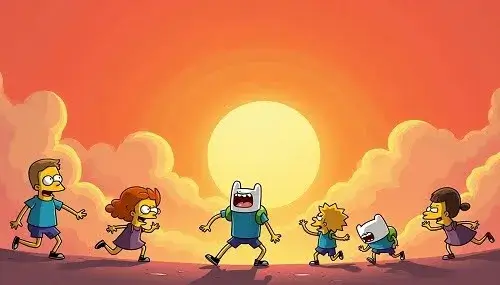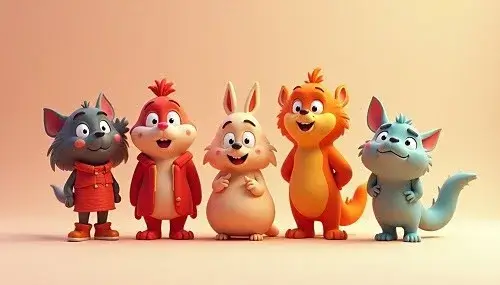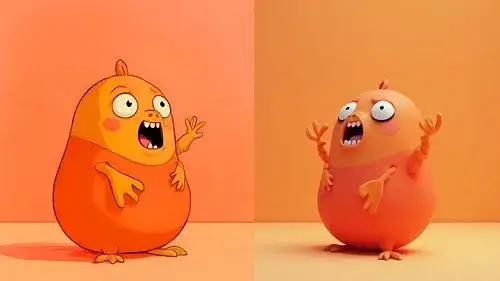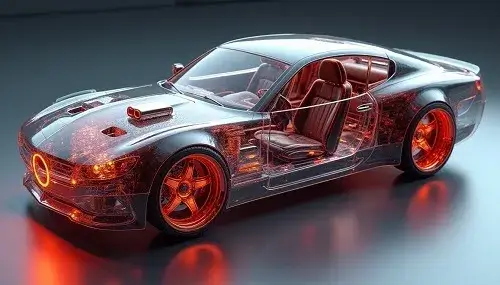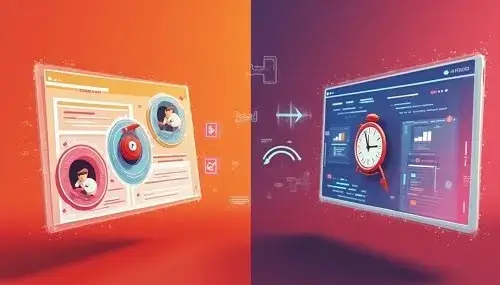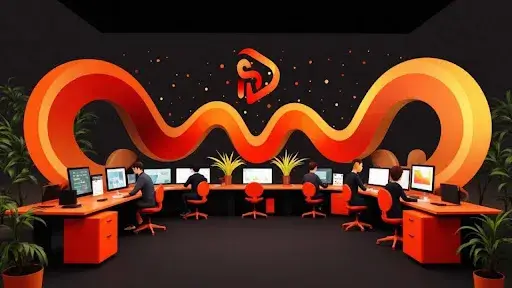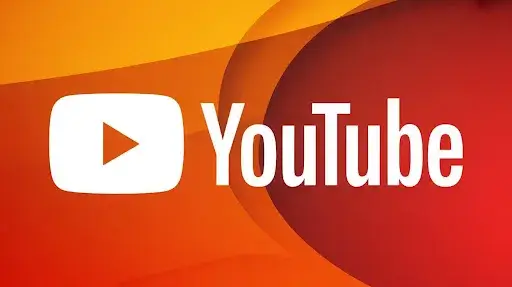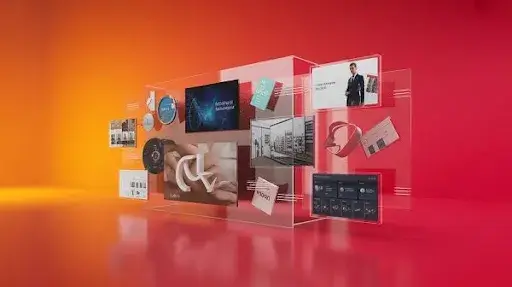You’re not here because you’re bored. You’re here because you want your project to work. Maybe you’re pitching a new product, telling a story that needs to stick, or bringing an idea to life for investors who don’t have time for a dull pitch deck. You’re wondering: 2D vs. 3D Animation – which one will actually get me the results I want?
So, you’re looking for animation services that perfectly fit your brand’s needs? In that case, it is crucial for you to have a strong understanding of the type of animation services you want based on your business’s values, target audience, and budget. This includes whether you want animation in 2D or 3D.
According to one report, the animation market is predicted to grow exponentially in revenue to USD 895.71 billion by 2034.
In this guide, I will present the definitions of 2D and 3D animation, explain the goals that can be achieved with each, outline the pros and cons of both 2D and 3D animation, and provide criteria to help you decide which animation best suits your brand.
What Is Animation, Really?
At its core, animation means giving life to still images. But that definition doesn’t help you much if you’re the one writing the check.
Notice that you’re funded with the artwork: talented professionals who know how to apply such key animation principles as timing, spacing, and motion, so your visuals grab attention, are going to pay off.
Most animation can be easily categorized into 2D and 3D. Additionally, it is noteworthy that blending 2D and 3D elements is very common; this indicates the necessity of having an understanding to be an informed decoder.
What Is 2D Animation?
2D animation is flat. That is certainly not to say that it is dull or forgettable. Consider some of the best examples of 2D animation, such as The Simpsons, Adventure Time, and Rick and Morty. All two-dimensional, yet unforgettable animation.
In 2D animation services, both characters and scenes are crafted within the parameters of height and width. Movement is achieved by playing frames in sequence, which can be created either manually or through the use of software.
An explainer video, a cheerful advertisement featuring animated characters, or a lively yet affordable animated logo are all examples of 2D animation.
Key 2D Animation Techniques
2D isn’t one size fits all. Here are a few core techniques you’ll see in the industry:
- Traditional (Cel) Animation: Artists draw every frame by hand. Painstaking but beautiful.
- Rotoscoping: Artists trace over live-action footage to add realism and depth.
- Motion Graphics: More stylized, often used for infographics or logo reveals.
- Stop Motion: Technically 2D when done with flat cutouts. It’s slow but unique.
Artists are no longer limited to stacks of paper and a lightbox, marking a significant leap in advancement. Adobe Animate, Toon Boom Harmony, and TV Paint are all treasured options for 2D animation. Each provides the ability to implement key animation digitally.
What Is 3D Animation?
3D animation looks and feels more realistic because it adds depth, literally. Instead of a flat image, artists construct a 3D model on the computer. A digital skeleton is created, and the model is instructed on movement, whether through keyframe animation or motion capture.
Only after the model is completed is rendering performed, where lighting, shadows, and textures are added to enhance the realism of the model’s final scene.
Deutsche Bank has a video that presents the company’s profile in a 3D animated video. It enables users to access every facet of the bank’s services. The 3D animation features its logo and tagline, creatively retaining the model’s features.
If you need to animate a vehicle, a surgical operation, or a 3D animated building model, 3D animation services are beneficial for depicting such accurate visual imagery.
Where Does 2D vs 3D Animation Overlap?
There’s a crossover between 2D and 3D animation, hybrid shows or ads that mix a 2D look with 3D models underneath. Some stylized movies fake a hand-drawn feel with 3D software. It’s clever and budget-friendly when you want the best of both.
Both types need artists with an eye for design. Both need storyboards, a clear idea, and solid direction. And both need smart buyers to know what they’re paying for.
Difference Between 2D and 3D Animation
So, what’s the real difference between 2D vs. 3D animation? Here’s the short version:
- Style: 2D is flat art; 3D is depth and realism.
- Production Time: 2D can be faster and cheaper, but only for simple scenes.
- Software Skills: 3D animation requires technical skills in modeling, rigging, and rendering.
- Additions: While a 3D model has its advantages, incorporating any additional features or changes one wishes to make will be considerably more difficult.
- Expenses: The production of 3D movies also incurs new costs, including 3D production, additional personnel, and higher equipment costs related to rendering and machine usage.
Pros and Cons of 2D and 3D Animation
Let’s break it down even further.
Pros of 2D Animation
- Shorter timelines for simple projects.
- More affordable for explainer videos and ads.
- Easy to stylize, such as cartoons, infographics, or anything playful.
Cons of 2D Animation
- Complex scenes require a significant amount of drawing time.
- Less realistic than 3D.
- Sometimes limited for technical demos.
Pros of 3D Animation
- Can create realistic animations, great for products, simulations, or effects.
- Easier to reuse models for future projects.
- Big wow factor when done well.
Cons of 3D Animation
- Learning curve is steep.
- Software can get expensive.
- Longer render times, which means bigger budgets.
Animation Techniques Buyers Should Know
You don’t need to become an animator overnight, but understanding a few industry terms makes you a sharper buyer.
Keyframe Animation
In both 2D and 3D animation, keyframe animation is used where the artist sets important frames, also known as keyframes. The software will then automate the processes of drawing in the animation to connect the keyframes.
Motion Capture
Mostly for 3D. Real actors wear suits with sensors, and their movements get translated to digital characters. Think Avatar or video games.
Rigging and Inverse Kinematics
For 3D, this is the skeleton that lets models move realistically. Inverse kinematics helps make limbs bend and swing like real joints.
Should You Learn 2D or 3D Animation If You’re Curious?
Some buyers want to learn the basics before hiring. Good idea. For several individuals, the initial approach is 2D. Principles are easier to learn, and the cost of 2D animation is generally cheaper than that of 3D animation.
If you’re hiring instead, look for a team that knows both. Sometimes your project will need a mix, 2D for story scenes, 3D for product shots.
2D vs 3D Animation Costs and Timelines
Your preferred animation style is not the only factor to consider. Given your budget, timeline, and flexibility, the style that is most appropriate would be greatly determined.
How Much Does 2D Animation Cost?
2D animation is often more budget-friendly for businesses testing an idea or launching a new product. It usually requires a smaller team and simpler software. But it’s a myth that 2D is always cheap.
- Basic 2D animation for social ads or explainer videos have lower cost, quick turnaround.
- For each additional frame in detailed 3D animated character design and animated scenes, the costs increase.
- Animation expenses incurred for filming each image frame tended to be high, as costs for animation are charged for each frame capture.
For 2D animation, the price for polished imagery is high as it is charged for the mastery, time, and design effort expended.
How Much Does 3D Animation Cost?
3D animation is a labor-intensive process that involves modeling, rigging, lighting, and rendering, and requires high-end computers as well as expensive, specialized software. In comparison to simpler animation types, 3D animation is more expensive as it requires large teams to operate.
- With product animations and walkthroughs, the upfront cost is higher; however, the reusable models and animations can be utilized in future videos, reducing overall costs.
- Complex character animations with motion capture. This adds additional costs but provides lifelike movement.
- Full 3D explainer videos can take weeks of production and rendering.
Many businesses use 3D when they need to create realistic animations for product launches, architectural previews, or medical procedures.
Know more about:
Timeline Differences
- 2D Animation: This process can take anywhere from a few days to a few weeks, depending on the project’s length and complexity.
- 3D Animation: This process often requires weeks to months, especially when detailed lighting, rendering, or revisions are involved.
If your launch is in two weeks, 3D might not be your best choice unless your project is simple.
What Type of Animation Fits Your Project?
When comparing the differences between 2D and 3D animation, consider your end goal.
Choose 2D animation if:
- You’re looking for a playful, stylized appearance.
- Your budget is tight.
- You need fast turnaround.
- Your message doesn’t require realism.
Choose 3D animation if:
- You need to create realistic animations of a product or scene.
- Your project benefits from depth and dynamic angles.
- You plan to reuse the model in multiple campaigns.
Real-World 2D Animation Examples
- Explainer Videos: Simple, colorful animations that explain apps or services.
- Animated Ads: Eye-catching social media ads.
- Storytelling: Short stories or training videos for internal teams.
Companies like Dropbox and Slack use 2D animation to break down complex ideas.
Real-World 3D Animation Examples
- Product Demos: Tech products shown from every angle.
- Medical Visualizations: Showing surgical procedures or drug mechanisms.
- Game Trailers: Immersive, high-detail cinematic reveals.
The use of 3D animation is common in industries such as technology and automotive for various reasons, including the exhibition of the latest features. Keyframe animation helps capture the intricate movements that are often seen in well-crafted visuals.
Furthermore, complex character 3D animations get improved thanks to motion capture techniques. This is an additional amount to the overall bill, but it is worth it if smoothness and efficiency are your top priorities.
2D vs 3D Animation for Marketing
If your goal is marketing, you’re not just buying visuals. You’re buying attention, retention, and action.
When 2D Animation Wins for Marketing
- Fast Product Launches: Explainers for landing pages.
- Social Media: Attention spans are short; quick, colorful 2D grabs viewers.
- Brand Storytelling: Consistent, stylized visuals can become an integral part of your brand identity.
When 3D Animation Wins for Marketing
- High-End Products: Show the sleekness of a device or car with cinematic angles.
- Medical or Tech: Demonstrate how something works with realistic details.
- Investor Pitches: A 3D flythrough of your product can leave a lasting impression.
Key 2D Animation Techniques for Buyers to Know
Understanding these can help you ask better questions when hiring:
- Frame-by-Frame: Artists draw each frame for smooth motion.
- Cut-Out Animation: Using pre-made assets for faster production.
- Rotoscoping: Tracing over video for lifelike motion.
- Motion Graphics: Shapes and text animations, often used for infographics, when benefit from motion graphics design services.
Key 3D Animation Techniques for Buyers to Know
- Modeling: Building 3D objects and characters.
- Rigging: Creating a skeleton for movement.
- Keyframe Animation: Setting key poses, letting software fill in motion.
- Motion Capture: Using real human motion for lifelike results.
Ready to Move Beyond Basics?
Till now, we’ve covered: basic understanding of both types of animation, their diverse uses, and pros and cons.
Tailor-made animation has many advantages. Therefore, partnering with a well-versed animation studio will do wonders for you, as you will be able to convey your brand’s image in engaging and convincing visuals. This, in turn, leads to more potential clients.
What to Prepare Before Hiring a 2D vs 3D Animation Studio
Preparation is crucial when you finally decide to work with an animation agency. Knowing exactly what you want will help you save quite a penny and, not to mention, hours of back-and-forth dialogues.
Define Your Goal
Before obtaining a quote, understand why you need animation.
- Selling a product?
- Training your team?
- Attracting investors?
- Boosting brand awareness?
Knowing your end goal will help the studio recommend the right type of animation for your project.
Gather References
Collect examples of 2D and 3D animation you like. Share animation examples with your studio so they understand your taste.
Prepare Your Script or Concept
You don’t need a polished script, but a rough outline helps. Animation projects move faster when studios know:
- Your target audience
- Key message
- Tone (playful, professional, bold)
Working With Prolific Studio Works
Here’s what you can expect when you hire one of the best animation companies in Atlanta, like Prolific Studio:
1. Discovery Call
We learn about your goals, brand, and audience. This is where we determine whether 2D animation or 3D animation best suits your needs and budget.
2. Script and Storyboard
If you don’t have a script, we will help draft one. Then, we create a storyboard to map out each scene.
3. Style Frames
We design a few key frames to lock in the visual style, colors, and tone.
4. Animation Production
Using key animation principles, our team moves into production. For 2D, we create character rigs or draw frames. For 3D, we model, rig, animate, and render.
5. Sound and Music
Music and sound design complete your project. We sync everything for maximum impact.
6. Revisions and Delivery
We provide drafts for your feedback. Once approved, you get your final animation in the formats you need.
Mistakes to Avoid When Buying Animation
Animation is an investment. Avoid these pitfalls:
- Selecting exclusively based on price is a pitfall: Qualitative value is often overlooked by responsive, low-cost providers who skip key steps, resulting in a stiff and low-quality end product.
- Unclear Goals: Not knowing what you want can lead to endless revisions.
- Skipping Storytelling: Animation isn’t just about visuals. It needs a clear message to resonate.
- Ignoring Branding: Your animation should match your brand’s tone, colors, and style.
- Expecting Overnight Results: Quality animation, especially 3D, takes time.
Frequently Asked Questions
How Long Does Animation Take?
- Simple 2D explainer: 2–4 weeks.
- Detailed 2D with characters: 4–6 weeks.
- 3D product animation: 6–8 weeks.
- Complex 3D character animation: 2–3 months.
What Files Will I Get?
Most of the time, you will be given MP4 or MOV files of your specified resolution. Discuss layered files for future edits early on to avoid disappointments later.
Can I Request Changes After Completion?
Yes, but major changes after final delivery may incur extra costs. It’s why clear feedback during drafts is important.
Do I Need a Voiceover?
Using voiceovers as part of explainer videos usually enhances engagement. However, for social media advertisement, it might be more effective to use captions.
Why Animation Is Worth It
Animation brings your product, service, or idea to life in a way that static images can’t. It can:
- Increase conversions on landing pages.
- Reduce support requests with clear explanations.
- Boost social engagement.
- Build a memorable brand identity.
You can repurpose animations across your website, social media platforms, investor pitches, and even during presentations.
2D vs 3D Animation: What’s Right for You?
To recap:
- 2D Animation: Ideal for explainer videos, storytelling, branding, and projects that benefit from a stylized aesthetic.
- 3D Animation: Perfect for realistic animations, product showcases, simulations, and high-impact visuals.
Both have their place. The right choice depends on your audience, message, and budget.
Final Word
You’ve learned the real difference between 2D vs 3D animation. You know what type of animation can boost your project, the pros and cons of 2D and 3D animation, and how to prepare as a smart buyer.
Now it’s your move.
Book a free consultation with Prolific Studio today, and let’s discuss how your message can move your audience.
Animation isn’t a luxury anymore. It’s your chance to stand out in a crowded space and make people pay attention. Let’s make it count.
Related Articles:




